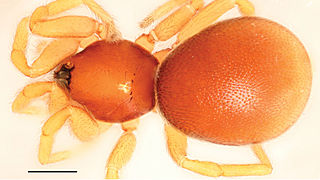
Ground spiders comprise Gnaphosidae, the seventh largest spider family with over 2,000 described species in over 100 genera distributed worldwide. There are 105 species known to central Europe, and common genera include Gnaphosa, Drassodes, Micaria, Cesonia, Zelotes and many others. They are closely related to Clubionidae. At present, no ground spiders are known to be seriously venomous to humans.

Oonopidae, also known as goblin spiders, is a family of spiders consisting of over 1,600 described species in about 113 genera worldwide, with total species diversity estimated at 2000 to 2500 species. The type genus of the family is OonopsKeyserling, 1835.

Ischnothyreus is a genus of oonopid spiders generally between 1.25 and 2.25 mm long. They have six eyes; in at least the species I. peltifer and I. omus, the males have a curious knob or hook at the base of the fang.

Caponiidae is a family of ecribellate haplogyne spiders that are unusual in a number of ways. They differ from other spiders in lacking book lungs and having the posterior median spinnerets anteriorly displaced to form a transverse row with the anterior lateral spinnerets. Most species have only two eyes, which is also unusual among spiders. A few species of Caponiidae variously have four, six or eight eyes. In some species the number of eyes will increase when the spiderling changes its skin as it grows towards adulthood.
Opopaea is a genus of goblin spiders of the family Oonopidae. The genus is one of the largest within the family, with 180 accepted species.
Aprusia is a genus of goblin spiders in the family Oonopidae, containing eight accepted species. seven species are endemic to Sri Lanka and the other species is endemic to India.
Brignolia is a genus of goblin spiders in the family Oonopidae, containing thirty one accepted species.

Xestaspis is a genus of goblin spiders that was first described by Eugène Louis Simon in 1884.
Iraponia is a monotypic genus of Asian araneomorph spiders in the family Caponiidae, containing the single species, Iraponia scutata. It was first described by Y. Kranz-Baltensperger, Norman I. Platnick & N. Dupérré in 2009, and has only been found in Iran.
Stenoonops is a genus of spiders in the family Oonopidae. It was first described in 1892 by Simon. As of 2017, it contains 28 species.
Trilacuna is a genus of goblin spiders native to Southeast Asia, first described by Tong & Li in 2007. They look similar to members of Silhouettella, but males can be distinguished by their large palpal femur, among several other more complicated defining features. The name is a combination of the Latin terms "tri" and "lacuna", referring to the three-branched endites in males and the three-notched labium in females.

Xyphinus is a genus of goblin spiders that was first described by Eugène Louis Simon in 1893.
Simonoonops is a genus of spiders in the family Oonopidae. It was first described in 2002 by Harvey. As of 2017, it contains 11 species.
Prodidomus is a genus of long-spinneret ground spiders that was first described by Nicholas Marcellus Hentz in 1847.
Cinetomorpha is a genus of goblin spiders first described by Eugène Louis Simon in 1892. It is a senior synonym of Lucetia, and Yumates.





